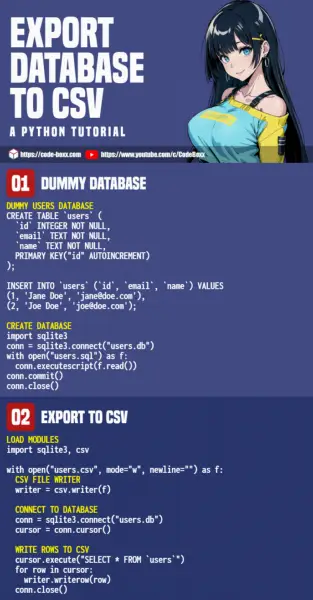Welcome to a tutorial on how to export a database to a CSV file. So you need to create a report from the database? Well, it’s a simple “select from the database, write to CSV file” process – Read on for the example!
TABLE OF CONTENTS
DOWNLOAD & NOTES
Here is the download link to the example code, so you don’t have to copy-paste everything.
EXAMPLE CODE DOWNLOAD
The example code is released under the MIT license, so feel free to build on top of it or use it in your own project.
SORRY FOR THE ADS...
But someone has to pay the bills, and sponsors are paying for it. I insist on not turning Code Boxx into a "paid scripts" business, and I don't "block people with Adblock". Every little bit of support helps.
Buy Me A Coffee Code Boxx eBooks
PYTHON EXPORT DATABASE TO CSV
All right, let us now get into the example of exporting an SQLite database to a CSV file.
TUTORIAL VIDEO
QUICK SETUP
The “usual stuff”:
- Create a virtual environment
virtualenv venv. - Activate it –
venv\Scripts\activate(Windows)venv/bin/activate(Linux/Mac)
PART 1) DUMMY DATABASE
1A) USERS TABLE
CREATE TABLE `users` (
`id` INTEGER NOT NULL,
`email` TEXT NOT NULL,
`name` TEXT NOT NULL,
PRIMARY KEY("id" AUTOINCREMENT)
);
INSERT INTO `users` (`id`, `email`, `name`) VALUES
(1, 'Jane Doe', 'jane@doe.com'),
(2, 'Joe Doe', 'joe@doe.com'),
(3, 'John Doe', 'john@doe.com'),
(4, 'Julie Doe', 'julie@doe.com'),
(5, 'Johan Doe', 'johan@doe.com'),
(6, 'Joanne Doe', 'joanne@doe.com'),
(7, 'Juliet Doe', 'juliet@doe.com'),
(8, 'June Doe', 'june@doe.com'),
(9, 'Juan Doe', 'juan@doe.com'),
(10, 'Jamir Doe', 'jamir@doe.com'),
(11, 'Jaden Doe', 'jaden@doe.com'),
(12, 'James Doe', 'james@doe.com'),
(13, 'Janus Doe', 'janus@doe.com'),
(14, 'Jason Doe', 'jason@doe.com'),
(15, 'Jay Doe', 'jay@doe.com'),
(16, 'Jeff Doe', 'jeff@doe.com'),
(17, 'Jenn Doe', 'jenn@doe.com'),
(18, 'Joah Doe', 'joah@doe.com'),
(19, 'Joyce Doe', 'joyce@doe.com'),
(20, 'Joy Doe', 'joy@doe.com'),
(21, 'Juke Doe', 'juke@doe.com'),
(22, 'Johnnie Doe', 'johnnie@doe.com'),
(23, 'Jim Doe', 'jim@doe.com'),
(24, 'Jess Doe', 'jess@doe.com'),
(25, 'Jabril Doe', 'jabril@doe.com');For this example, we will work with this dummy users table. Pretty self-explanatory.
idUser ID. Primary key and auto-increment.nameUser’s name.emailUser’s email.
1B) CREATE DATABASE
import sqlite3
conn = sqlite3.connect("users.db")
with open("S1A_users.sql") as f:
conn.executescript(f.read())
conn.commit()
conn.close()
print("Database created!")This will read the above SQL and create the actual users.db database file.
PART 2) EXPORT DATABASE TO CSV
# (A) LOAD MODULES
import sqlite3, csv
# (B) EXPORT ALL USERS TO CSV
with open("users.csv", mode="w", newline="") as f:
# (B1) CSV FILE WRITER
writer = csv.writer(f)
# (B2) CONNECT TO DATABASE
conn = sqlite3.connect("users.db")
cursor = conn.cursor()
# (B3) WRITE ROWS TO CSV
cursor.execute("SELECT * FROM `users`")
for row in cursor:
print(row)
writer.writerow(row)
conn.close()Long story short – “Fetch rows from the database, write to CSV file”.
EXTRAS
That’s all for the tutorial, and here is a small section on some extras and links that may be useful to you.
INFOGRAPHIC CHEATSHEET

LINKS & REFERENCES
THE END
Thank you for reading, and we have come to the end. I hope that it has helped you to better understand, and if you want to share anything with this guide, please feel free to comment below. Good luck and happy coding!
